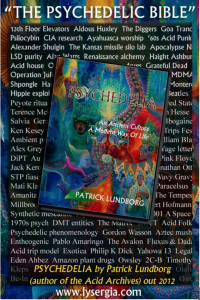[An interview with Lundborg and myself that discusses the current state of psychedelic research, as well as the Untold Fables of Terrence McKenna, is forthcoming.]
Patrick Lundborg’s weighty tome Psychedelia respectfully adds to the definitive meta-psychedelic cultural commentary sparked first by Daniel Pinchbeck’s now infamous Breaking Open the Head. Psychedelia is one of the most essential books in the argument for psychedelic shamanism and self-initiation into metaphysical mysteries—at this critical juncture of the post-internet age.
Lundborg’s pleasantly daunting 520 page text is almost medieval in its prying, penetrating philosophical musings, carefully sculpting out what he deems to be the Unified Psychedelic Theory. The UPT confidently allows for psychedelic culture to be understood on its own terms, instead of being a by-product of psychology or the history of religion. Like author James Oroc, [1] Lundborg also views the 21st century as the dawn of a carefully sophisticated, nuanced and scholarly approach to the inevitable second psychedelic renaissance.
The core argument of UPT is based on an unbiased phenomenological approach to the psychedelic theory that, like James Oroc and Rak Razam’s recent writing on 5-MeO-DMT and ayahuasca respectively (oddly omitted from Lundborg’s otherwise impeccably researched bibliography [2],) proposes to carefully isolate and map the Innerspace of the perilous journey of the cosmically courageous psychonaut. Lundborg defines the four stages of the general trip model as: Sensory Realm, Recollective-Analytic Stage, Symbolic Level, and Transcendental Level—the last of which often coincides at the peak experience of the journey and pertains to the relatively common experience of ego loss.
The first half of the book remains centered on the untold story of underground psychedelic history, citing rare stories and interviews that will astound and entertain both seasoned veterans and newcomers to the subject. The wide spanning history is presented in a non-linear and slightly fragmented fashion that entertains while it informs, covering everything from Neoplatonism and Swedenborg to Philip K. Dick, EDM and cyberpunk. Lundborg’s impressive academic background as a historian of religion, philosopher, information scientist and curator of the acclaimed Acid Archives (2010) penned for the UK Wire magazine, also gives him a considerable advantage in this essential cultural history, which was is the end product of over 20 years of research.
Lundborg argues that the ancient mystery cult of psychedelia began with Hoffman, Ruck and Wasson’s controversial speculations on the Elusian mysteries. Hoffman and co. presented a still controversial theory that the kykeon sacrament given to the initiate was an early organic synthesis of proto-LSD [3]. This theory is now being re-affirmed by the recent explosion of various academic publications [4] centered around entheogenic history, evolution and the development of culture informed by altered states of consciousness.
The second half concentrates more specifically on what informs what Lundborg calls the psychedelicist; a subject who need not necessarily refer to religious history or outdated psychological theory to be apart of the new global mystery cult, that nonetheless remains desperate in its thirst for veritable alchemical Gnosis [5].
Lundborg, like Razam, Oroc, and Luke [6] seem particularly enamored by the quintessential mysteries of the tryptamine phenomena. In the last two chapters, Lundborg utilizes Benny Shanon’s phenomenological approach to ayahuasca, along with Michael Winkelman’s neuropsychological model of altered consciousness and Paul MacLean’s triune brain theory to propose a far-reaching but sound theory called pan-spermia which argues that
“human ancestry once existed which possessed cerebral abilities which were different and in some respects superior to anything man today has acquired through microevolution…”
While the aforementioned authors are generally skeptical of yogic models that would verify or support the entheogenic experience, I would argue that the tryptamine peak experience corresponds perfectly to Yoga of Sound of Surat Shabd Yoga, a relatively unknown spiritual tradition that centers on the initiate conforming to the primal God‐Into‐Expression‐Power of the original creative sound of the Plotinian One through meditation, in order to surf the astral and causal planes out of the domain of psycho-physicality to eventually attain union with the ineffable Godhead.
The detailed metaphysics of the universal Innerspace journey correspond to the cosmology of four worlds that extend from matter to pure spirit.
In Razam’s recent documentary film Aya Awakenings, which depicts a harrowingly intense 5-MeO-DMT experience, he proclaims that translinguistic pure consciousness isolated out of the psycho-physical complex is “IT”. In the oft forgotten 1970’s Indian guru Kirpal Singh’s words, “IT” is the original OHM, the Pythagorean music of the spheres:
“The ancient Greeks also spoke of Shabd. In the writings of Socrates, we read that he heard within him a peculiar Sound which pulled him irresistibly to higher spiritual realms. Pythagoras also talked of Shabd. Plato spoke of It as the “Music of the Spheres.” In the Greek language we have the term Logos, from “logo,” to speak, which stands for the “Word” or Second Person of the Trinity. This term Logos also figures in both Hebrew and Christian philosophy and theology and in its mystic sense is used both by the Hellenistic and Neo-platonist philosophies. St. John has used the term “Word.” It is a Sound Principle (Shabd) emanating from the Great Silence (Ashabd).” [7] (My italics)
While 5-MeO-DMT may provide first access to this realm of pure metaphysical sound-light energy, what remains is for the individual initiate to go back through natural means in psycho-spiritual methods to deepen, ground and integrate the experience, in order that the seeker need not continually have to rely on the tools to catalyze the experience. Alan Watts’ infamous dictum “If you get the message, hang up the phone.” never tires, as a cautionary claim.
In sum, Lundborg’s provocative text, Psychedelia, paves the way for a number of different inquiries into cutting edge entheogenic research and altered traits. It is absolutely required reading for any psychedelicist.
***
[1] See Oroc’s “The Second Psychedelic Revolution Part One: The End of Acid,” part one of a five part series on the new psychedelic renaissance. Lundborg is perhaps more respectful in comparison to Oroc in regards to LSD being able to catalyze a non-dual mystical state, and asserts the transcend and include model: “Psychedelic experiences, primarily at high doses, poke holes through our common mind-state and allow us to peek into a consciousness state extant at a level of abstraction one node higher up. All our efforts at reducing reflexive behavior and animalistic impulses can be viewed as rungs on the ladder towards the whole through which we can peek.”Psychedelia p. 518.
[2] The index for Psychedelia is so expansive that Lundborg opted to allow readers to download it as a separate .pdf attachment, which can be viewed here.
[3] See Hoffman, Ruck and Wasson’s The Road To Eleusis.
[4] For a post T. McKenna theory of evolution and entheogens see “Altered Consciousness and Drugs in Human Evolution,” by Michael Winkelman. A few recent worthwhile books not mentioned by Razam, Oroc or Lundborg’s otherwise extensive bibliographies that affirm the new psychedelic renaissance include but are not limited to:
Exploring the Edge Realms of Consciousness ed. by Daniel Pinchbeck and Ken Jordan, LSD, Spirituality, and the Creative Process by Marlene Dobkin De Rios, Breaking Convention: Essays on Psychedelic Consciousness edited by Dr. Ben Sessa. The Psychedelic Renaissance: Reassessing the Role of Psychedelic Drugs in 21st Century Psychiatry and Society by Dr. Ben Sessa. Manifesting Minds: A Review of Psychedelics in Science, Medicine, Sex, and Spirituality edited by Rick Doblin. Entheogens and the Future of Religion by Robert Forte. The Psychedelic Future of the Mind: How Entheogens Are Enhancing Cognition, Boosting Intelligence, and Raising Values by Thomas B. Roberts The New Science of Psychedelics: At the Nexus of Culture, Consciousness, and Spirituality, by David Jay Brown. Rainforest Medicine: Preserving Indigenous Science and Biodiversity in the Upper Amazon by Jonathon Miller Weisberger, Entheogens, Society & Law: Towards a Politics of Consciousness, Autonomy & Responsibility by Daniel Waterman, Neuropsychedelia: The Revival of Hallucinogen Research since the Decade of the Brain by Nicolas Langlitz, Dropping Acid by Dale Bewan, The Acid Diaries: A Psychonaut’s Guide to the History and Use of LSD by Christopher Gray, and Psychedelic Psychiatry: LSD from Clinic to Campus by Erika Dyck.
[5] On the global gnosis phenomena and how it relates transformative networks in the post-internet age see RS editor of Psychedelic Culture Jeremy Johnson’s “The Invisible Networks: Gnosis, Glass Refractions and the Integral Age.” On Gnosis in general see Gabriel D. Roberts “Gnosis As A Bridge Between Us.” For how alchemy and the perennial philosophy relate to entheogens see “Of Ether, Entheogens and Colloidal Gold.” by Hereward Tilton in Aaron Cheak’s Alchemical Traditions: From Antiquity to the Avant-Garde.
[6] For an exhaustive account of how the tryptamine phenomena relates to the paranormal, metaphysical entities and near death experiences see David Luke’s comprehensive “Psychoactive Substances and Paranormal Phenomena: A Comprehensive Review.” See also my article “Beyond the Machine Elves.”, on how the tryptamines relates to 21st century entheodelic storytelling. David Metcalfe’s “In Beautiful Dreams: Nurturing Narratives and the Forgotten Potentials of Digital Culture,” is also an expansive musing at how transmedia art applies to entheodelic storytelling.
[7] The cosmology of the four worlds extends from gross matter to pure spirit as it is portrayed in this detailed comparative graph, comparing various historical consciousness altering traditions: http://www.kheper.net/integral/emanational.html
[8] In the Beginning was the Word” from the Gospel of Saint John is here referring not to literal words, language or speech, but the primal God‐Into‐Expression‐Power of the original sound of creation. This is also how both Tolkien’s The Silmarillion and the Upanishads open up in explanation of the dawn of creation. See Singh’s Naam or Word for an exhaustive account of the spiritual explanation of metaphysical energy/sound/light. For arguments of the origin of Greek philosophy being informed by out of body theurgic experiences of Egyptian/Sumerian magic and mysticism see Algis Uzdavinys’ Philosophy as a Rite of Rebirth: From Ancient Egypt to Neoplatonism and Orpheus and the Roots of Platonism.
Main image: “Primordial Presence” by Hakan Hisim
















